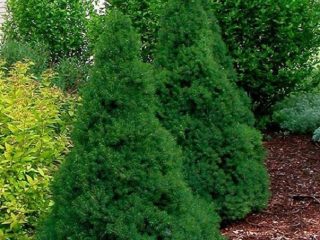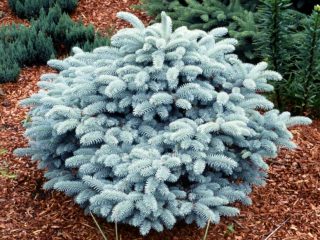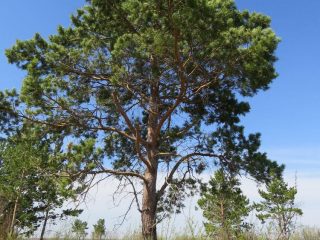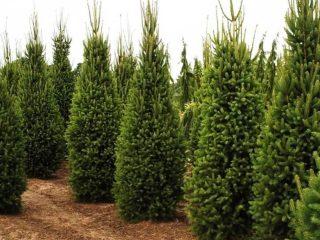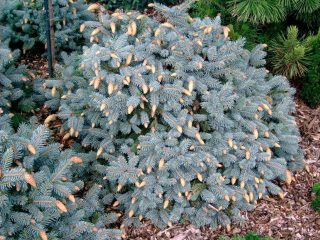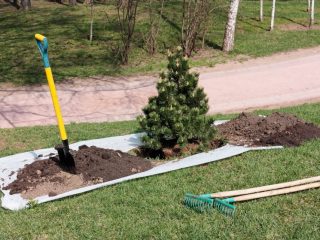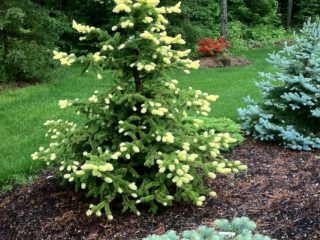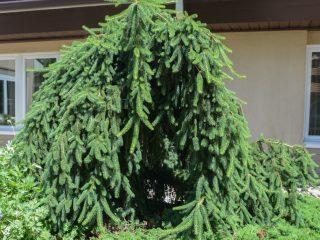Content
Blue Mountain spruce is a prominent representative of American thorny crops. For its excellent decorative properties it is used in landscape design. The plant does not require much care and is not picky about the soil, which makes it popular in different countries.
History of origin

Blue Mountain seeds take root after 3-4 months of cultivation
Many blue spruces passed through the Dutch nursery in Deurn. Blue Mountain is no exception. The variety appeared as a result of crossing Colorado spruce and Glauk. Date of breeding: 1990. The variety does not have a specific founder, since the research was carried out by a group of scientists. The work took about 15 years. The breeders were not sure whether the crop would take root.
Blue Mountain was officially registered only in 2005. But the variety quickly migrated to other regions.
Description of Blue Mountain Spruce
Spruce has pleasant turquoise needles. The needles are long and prickly, densely located, making it difficult to approach the trunk of an adult specimen. A waxy coating is barely noticeable on the needles, which performs a protective function.It prevents the destruction of needles during strong winds and precipitation.
Blue Mountain grows quietly in large cities and is not afraid of harmful gases. Thanks to this feature, it is used to decorate various areas - parks, gardens, memorial sites, highways, etc. With prolonged contact with gases, it purifies the air. The filtering properties are due to the high concentration of phytoncides. The plant is resistant to both frost and drought. The branches are strong enough to withstand wind and snowdrifts.
Spruce takes root well in open areas accessible to sunlight. Possible placement in partial shade. If you exclude contact with the sun, Blue Mountain will lose color and the needles will become sparser. Optimal soil conditions are dry or slightly moist soil. It is advisable to plant spruce in acidic or moderately acidic soil.
The crown is symmetrical and grows evenly throughout life. The trunk looks straight up, the branches are massive, growing in a horizontal direction. Blue Mountain exudes a pleasant forest aroma. The needles reach a length of about 3.2 cm. The fruits are medium in size - from 4 to 9 cm. At the beginning of ripening they are gray-green in color, then they begin to darken and turn brown.

Blue Mountain requires no pruning due to uniform growth
Blue Mountain spruce height
Translated from English, the name of the variety means “Blue Mountain”. Culture did not receive it by chance. In favorable conditions, the plant can reach 20-24 m, but such figures are only possible in a Western climate. In Russia, the dimensions will be significantly lower - no more than 16 m with a crown diameter of 3.5-4.5 m.
Frost resistance
Blue Mountain is not afraid of snow or wind.She calmly survives harsh winters without slowing down the pace of development. However, temperatures below -40 °C are undesirable, since the top of the spruce will constantly freeze and may fall off in strong gusts of wind. Planting in the far north is unacceptable.
Advantages and disadvantages
Blue Mountain spruce has a pleasant appearance, which is why it is revered by designers. It emits a pleasant aroma that has a filtering effect.

Blue Mountain's strong branches can easily withstand the weight of snow
Pros:
- resistance to temporary drought;
- possibility of landing in the Russian climate;
- high frost resistance;
- requires almost no maintenance;
- can be planted within the city.
Minuses:
- does not tolerate excess moisture.
Landing rules
It is necessary to select an open area, preferably on the eastern side. Planting on the coastal strip is not possible because the roots will not have good support. Due to high soil moisture, the root system will become sick.
The soil is prepared from dry leaves, turf, river sand and peat. Planting a crop requires compliance with basic agrotechnical practices. It is not necessary to dig up the ground; drainage is built in the hole from stones or coarse sand. The root collar is deepened no lower than ground level. Once planted, Blue Mountain needs plenty of water. At an early stage this will stimulate growth, the owner will need to prepare 45 liters of water.
Care instructions
Spruce is unpretentious, so it is not necessary to adhere to special rules for caring for it. For normal growth, timely watering, mulching for the winter, periodic weeding and shallow loosening are necessary.
When frost arrives, peat (no more than 7 cm) is added to the tree trunk area. During the growing season it is mixed with a lump of earth. Young seedlings are not able to survive harsh winters on their own. They need shelter.
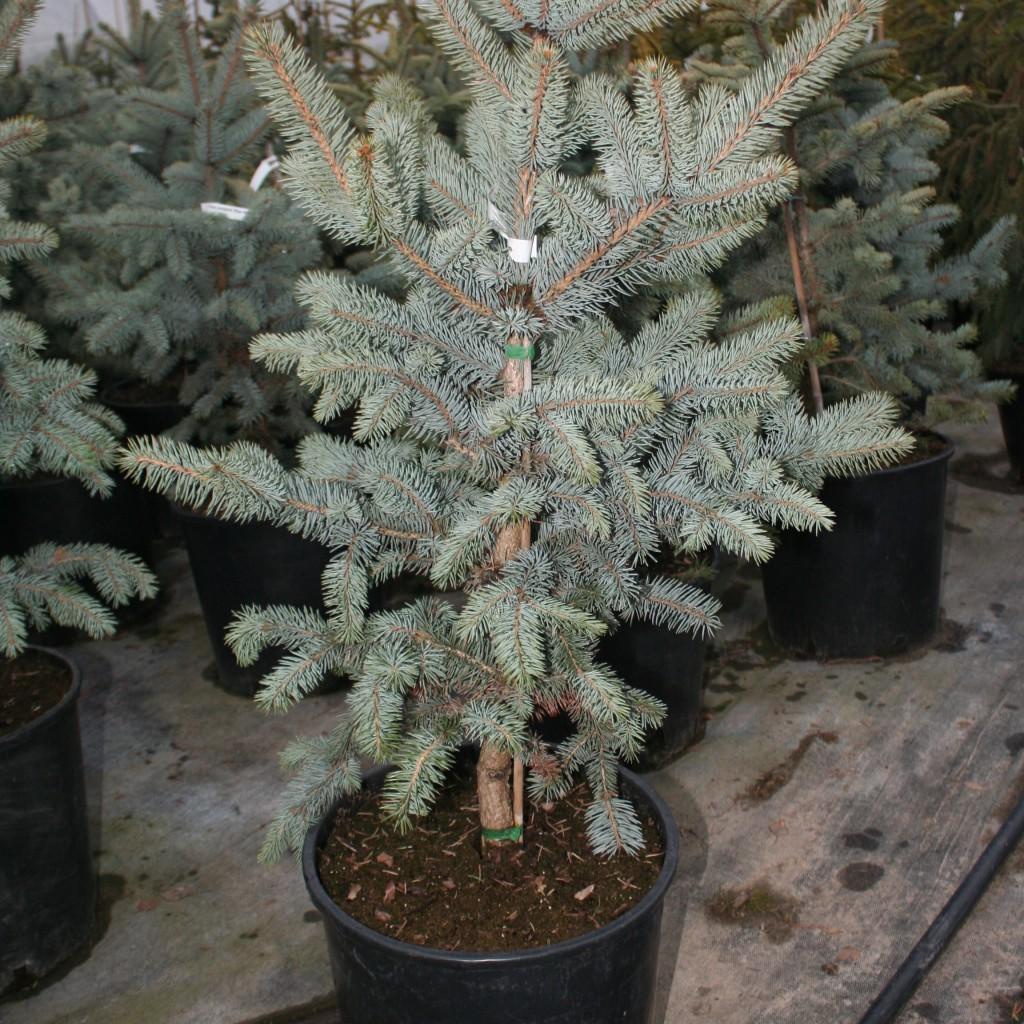
Blue Mountain seedlings like the soil to be fairly moist, but this need disappears as they age.
Blue Mountain does not require pruning because the needles grow slowly and symmetrically. Only dried branches are removed. Work is carried out at the end of May or beginning of June.
Reproduction
Blue Mountain can be propagated in two ways - cuttings and seeds. The last method is the most labor-intensive, since the seedling will only form after several years. The seeds are prepared in the fall, treated with potassium permanganate and placed in a cool place - a cellar or refrigerator. After the onset of spring, they are planted in a warm place.
Cuttings can be prepared either in spring or autumn. A young spruce about six years old is chosen as the mother. The cut shoots must be at least 20 cm. Stones are placed in the hole to create a drainage cushion, and the top is covered with fertile soil and a layer of sand (4-6 cm). The cuttings are treated with potassium permanganate and deepened into the soil. Young seedlings are shaded.
Diseases and pests
Blue Mountain spruce has strong immunity, but if not cared for, it can develop Schutte and rust. Symptoms may affect the stem, roots, needles and cones. Natural pests are spruce mites and sawflies. Both insects actively eat needles. The result of the attack may be an asymmetrical crown shape.
Blue Mountain Spruce in Landscape Design
Culture gets along well in urban environments. It can be combined with other trees except apple trees.The latter, due to their long roots, will “take away” nutrients and slow down the growth rate. Blue Mountain is used for single planting or in a group.

Blue Mountain blue spruce looks great when paired with brown and bright green.
Conclusion
Blue Mountain spruce is a frost-resistant variety, distinguished by its unpretentiousness and luxurious blue crown. The most favorable region for planting is Canada and the USA. It does not grow for so long in the Russian climate, but it is popular. The culture is valued for the filtering properties of its needles.
Reviews of Blue Mountain prickly spruce
